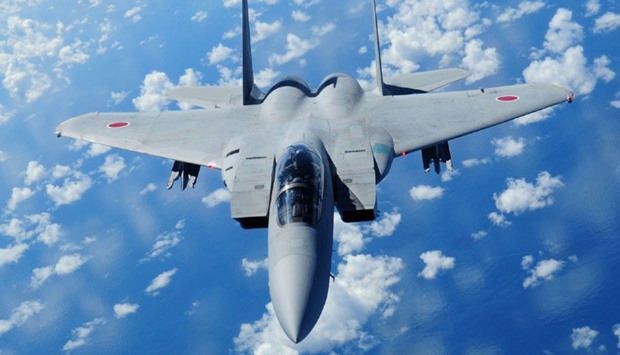
A Japanese air force F-15.
Japan has doubled the number of F-15 fighter jets deployed on the southern island of Okinawa, near disputed islands in the East China Sea, the defence ministry said yesterday.
Japan’s air self-defence Force now has about 40 F-15s on Okinawa’s Naha base, according to the defence ministry.
The move comes as Japan and China have routinely clashed over ownership of the Tokyo-controlled Senkaku Islands in the East China Sea.
Japan administers the uninhabited islands under that name but China also claims them and calls them the Diaoyus.
Chinese ships – mostly coast guard vessels – and aircraft have approached them to back up Beijing’s claims and test Japan’s response.
“This is a very front line of national defence,” said deputy defence minister Kenji Wakamiya, quoted by Jiji Press, at the ceremony yesterday at the Naha base to mark the creation of a new unit composed of the extra jets.
The defence ministry moved about 20 F-15s from the Tsuiki base in the southwestern island of Kyushu to Naha, the defence ministry said.
China has condemned the United States for sailing another warship near a disputed island in the South China Sea, the latest spat in a growing international row over who controls one of Asia’s key shipping routes.
A US destroyer sailed into the area of the sea containing the Paracel Islands group, and within 12 nautical miles of Zhongjian Island, or Triton Island in English, on Saturday, the defence department said.
Chinese defence ministry spokesman Yang Yujun said that Chinese troops, ships and warplanes identified and verified the ship, “warned and expelled it swiftly”.
Twelve nautical miles is how far from its shoreline a country can claim sovereign territory, under international laws of the sea.
The US “sent its warship into China’s territorial sea without authorisation. It is a deliberate provocation,” he said in a statement late Saturday.
The USS Curtis Wilbur was on “a freedom of navigation operation ... to challenge excessive maritime claims of parties that claim the Paracel Islands,” defence department spokesman Mark Wright said.
China, Taiwan and Vietnam all have claims to the island chain known as Xisha in Chinese and Hoang Sa in Vietnamese. China took control and stationed troops on the islands after the Battle of the Paracel Islands with South Vietnam in 1974.
China claims more than 80% of the South China Sea and its potentially oil-rich islands, putting it in conflict with overlapping claims by the Philippines, Vietnam, Malaysia, Brunei and Taiwan.
It has recently landed a test flight on a new air strip on Fiery Cross Reef, one of the many islands it has expanded, but which is also claimed by Vietnam.
The US has called for all land reclamation and construction on the reefs and islets to be stopped.
Any foreign fleet must obtain a permit from the Chinese government before entering China’s territorial waters, foreign ministry spokeswoman Hua Chunying was quoted as saying on the ministry website Saturday.
“We urge the US side to respect, abide by Chinese laws and do more to help China-US mutual trust and regional peace and stability,” she said.
“No claimants [to that area of the sea] were notified prior to the transit, which is consistent with our normal process and international law,” Wright said in a statement.
The US sent two warships and bombers into disputed areas last year, provoking angry responses from Beijing, which called the actions “illegal”.
Some $5tn of maritime trade passes through the South China Sea each year, and it is also thought to be rich in mineral resources.
